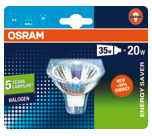Following on from my post last year about Philips’ new higher efficiency halogen lamps I see that Osram have launched a whole new “energy saving” range too (see their website). This covers a wide range of filament lamps, curiously including a regular old-fashioned bayonet cap bulb!

Personally I’m only interested in the MR16 fittings. Their website suggests a 35W energy saver was equivalent to 50W ordinary bulb and a 20W was equivalent to 35W ordinary, i.e. comparable to Philips Masterline ES bulbs. I assume these are approximate numbers for public consumption but suggest a 30-40% energy saving. Depressingly though they do offer a 50W version which they say is equivalent to 65W – not so large energy savings but I suppose if people have transformers already rated for a 50W bulb maybe some will want even more light.
Screwfix has a 5 pack of Osram Energy Saver 20W at £17.45 i.e. £3.49 each inc VAT, so this is probably very roughly twice the price of an standard branded (2000h) bulb and is £1.19 more than an Osram long life 35W (4000h) bulb.
The energy saver lamp is rated at 5000h but let’s assume it is 4000h for the sake of an easy calculation! If we compare a 20W energy saver it to a 35W long life bulb it will in theory save 60kWh over its lifetime, or about £4.20 assuming a secondary electricity tariff of 7p/unit. The comparison with a standard bulb gives the same electricity saving and purchase costs except that you have to change the bulb twice instead of once!
Therefore you save more than the purchase price of the bulb in reduced electricity consumption over its lifetime. Therefore, unless you find someone giving halogen bulbs away for free, using Energy Saver replacement halogen bulbs is the obvious choice for both financial and environmental reasons.
Footnote:
It is encouraging to see developments like these in tungsten lamps. Whilst I agree with comments from other people on this blog that LEDs are probably the future for low power lighting (& I stumbled into an Osram press release about LED car headlamps whilst writing this), continued improvements in halogen bulbs may see them becoming as energy efficient as CFCs in downlights. For example, I would be interested to compare performance of a 10W energy efficient halogen to a 10W CFC.
Leave a comment